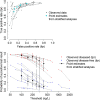Quantifying how diagnostic test accuracy depends on threshold in a meta-analysis
- PMID: 31571244
- PMCID: PMC6856843
- DOI: 10.1002/sim.8301
Quantifying how diagnostic test accuracy depends on threshold in a meta-analysis
Erratum in
-
Correction: Quantifying how diagnostic test accuracy depends on threshold in a meta-analysis.Stat Med. 2021 Aug 15;40(18):4166. doi: 10.1002/sim.9103. Epub 2021 Jun 13. Stat Med. 2021. PMID: 34120359 Free PMC article. No abstract available.
Abstract
Tests for disease often produce a continuous measure, such as the concentration of some biomarker in a blood sample. In clinical practice, a threshold C is selected such that results, say, greater than C are declared positive and those less than C negative. Measures of test accuracy such as sensitivity and specificity depend crucially on C, and the optimal value of this threshold is usually a key question for clinical practice. Standard methods for meta-analysis of test accuracy (i) do not provide summary estimates of accuracy at each threshold, precluding selection of the optimal threshold, and furthermore, (ii) do not make use of all available data. We describe a multinomial meta-analysis model that can take any number of pairs of sensitivity and specificity from each study and explicitly quantifies how accuracy depends on C. Our model assumes that some prespecified or Box-Cox transformation of test results in the diseased and disease-free populations has a logistic distribution. The Box-Cox transformation parameter can be estimated from the data, allowing for a flexible range of underlying distributions. We parameterise in terms of the means and scale parameters of the two logistic distributions. In addition to credible intervals for the pooled sensitivity and specificity across all thresholds, we produce prediction intervals, allowing for between-study heterogeneity in all parameters. We demonstrate the model using two case study meta-analyses, examining the accuracy of tests for acute heart failure and preeclampsia. We show how the model can be extended to explore reasons for heterogeneity using study-level covariates.
Keywords: Box-Cox transformation; ROC curve; evidence synthesis; sensitivity; specificity; test cutoff.
© 2019 The Authors. Statistics in Medicine Published by John Wiley & Sons Ltd.
Figures





Similar articles
-
Folic acid supplementation and malaria susceptibility and severity among people taking antifolate antimalarial drugs in endemic areas.Cochrane Database Syst Rev. 2022 Feb 1;2(2022):CD014217. doi: 10.1002/14651858.CD014217. Cochrane Database Syst Rev. 2022. PMID: 36321557 Free PMC article.
-
Modelling multiple thresholds in meta-analysis of diagnostic test accuracy studies.BMC Med Res Methodol. 2016 Aug 12;16(1):97. doi: 10.1186/s12874-016-0196-1. BMC Med Res Methodol. 2016. PMID: 27520527 Free PMC article.
-
Total serum bile acids or serum bile acid profile, or both, for the diagnosis of intrahepatic cholestasis of pregnancy.Cochrane Database Syst Rev. 2019 Jul 5;7(7):CD012546. doi: 10.1002/14651858.CD012546.pub2. Cochrane Database Syst Rev. 2019. PMID: 31283001 Free PMC article.
-
A diagnostic test accuracy meta-analysis of maternal serum ischemia-modified albumin for detection of preeclampsia.J Matern Fetal Neonatal Med. 2019 Jul;32(13):2173-2181. doi: 10.1080/14767058.2018.1427724. Epub 2018 Jan 24. J Matern Fetal Neonatal Med. 2019. PMID: 29325458
-
Screening for Cognitive Impairment in Older Adults: An Evidence Update for the U.S. Preventive Services Task Force [Internet].Rockville (MD): Agency for Healthcare Research and Quality (US); 2020 Feb. Report No.: 19-05257-EF-1. Rockville (MD): Agency for Healthcare Research and Quality (US); 2020 Feb. Report No.: 19-05257-EF-1. PMID: 32129963 Free Books & Documents. Review.
Cited by
-
An empirical comparison of statistical methods for multiple cut-off diagnostic test accuracy meta-analysis of the Edinburgh postnatal depression scale (EPDS) depression screening tool using published results vs individual participant data.BMC Med Res Methodol. 2024 Feb 1;24(1):28. doi: 10.1186/s12874-023-02134-w. BMC Med Res Methodol. 2024. PMID: 38302928 Free PMC article.
-
Health Economic Decision Tree Models of Diagnostics for Dummies: A Pictorial Primer.Diagnostics (Basel). 2020 Mar 14;10(3):158. doi: 10.3390/diagnostics10030158. Diagnostics (Basel). 2020. PMID: 32183372 Free PMC article.
-
TOMAS-R: A template to identify and plan analysis for clinically important variation and multiplicity in diagnostic test accuracy systematic reviews.Diagn Progn Res. 2022 Sep 22;6(1):18. doi: 10.1186/s41512-022-00131-z. Diagn Progn Res. 2022. PMID: 36131330 Free PMC article.
-
Faecal immunochemical tests for patients with symptoms suggestive of colorectal cancer: An updated systematic review and multiple-threshold meta-analysis of diagnostic test accuracy studies.Colorectal Dis. 2024 Dec 17;27(1):e17255. doi: 10.1111/codi.17255. Online ahead of print. Colorectal Dis. 2024. PMID: 39690130 Free PMC article. Review.
-
Diagnostic accuracy of the aortic dissection detection risk score alone or with D-dimer for acute aortic syndromes: Systematic review and meta-analysis.PLoS One. 2024 Jun 21;19(6):e0304401. doi: 10.1371/journal.pone.0304401. eCollection 2024. PLoS One. 2024. PMID: 38905181 Free PMC article.
References
-
- Reitsma JB, Glas AS, Rutjes AWS, Scholten RJPM, Bossuyt PM, Zwinderman AH. Bivariate analysis of sensitivity and specificity produces informative summary measures in diagnostic reviews. J Clin Epidemiol. 2005;58(10):982‐990. - PubMed
-
- Chu HT, Cole SR. Bivariate meta‐analysis of sensitivity and specificity with sparse data: a generalized linear mixed model approach. J Clin Epidemiol. 2006;59(12):1331‐1332. - PubMed
-
- Rutter CM, Gatsonis CA. A hierarchical regression approach to meta‐analysis of diagnostic test accuracy evaluations. Statist Med. 2001;20(19):2865‐2884. - PubMed
-
- Macaskill P, Gatsonis C, Deeks J, Harbord R, Takwoingi Y. Chapter 10: analysing and presenting results In: Deeks JJ, Bossuyt PM, Gatsonis C, eds. Cochrane Handbook for Systematic Reviews of Diagnostic Test Accuracy. London, UK: The Cochrane Collaboration; 2010:1‐59.
Publication types
MeSH terms
Substances
Grants and funding
LinkOut - more resources
Full Text Sources
Medical
